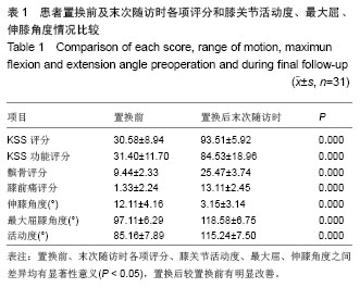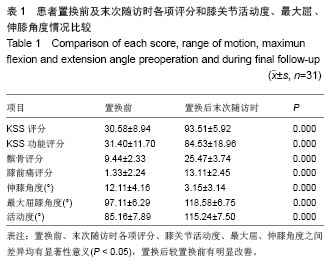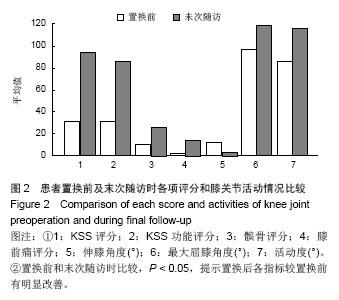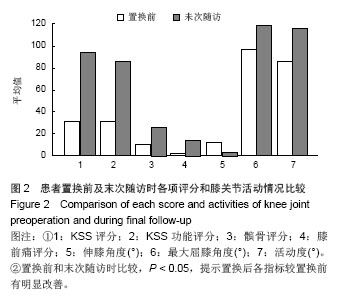Chinese Journal of Tissue Engineering Research ›› 2014, Vol. 18 ›› Issue (26): 4101-4107.doi: 10.3969/j.issn.2095-4344.2014.26.001
Medium-term follow-up after mobile-bearing total knee arthroplasty
Wang Guo-dong1, Guo Ai2, Qiang Hua1, Zhao Er-hong1
- 1 Department of Orthopedics, Beijing Tongren Hospital, Capital Medical University, Beijing 100730, China; 2 Beijing Friendship Hospital, Capital Medical University, Beijing 100050, China
-
Online:2014-06-25Published:2014-06-25 -
Contact:Zhao Er-hong, Department of Orthopedics, Beijing Tongren Hospital, Capital Medical University, Beijing 100730, China -
About author:Wang Guo-dong, Attending physician, Department of Orthopedics, Beijing Tongren Hospital, Capital Medical University, Beijing 100730, China
CLC Number:
Cite this article
Wang Guo-dong, Guo Ai, Qiang Hua, Zhao Er-hong. Medium-term follow-up after mobile-bearing total knee arthroplasty [J]. Chinese Journal of Tissue Engineering Research, 2014, 18(26): 4101-4107.
share this article
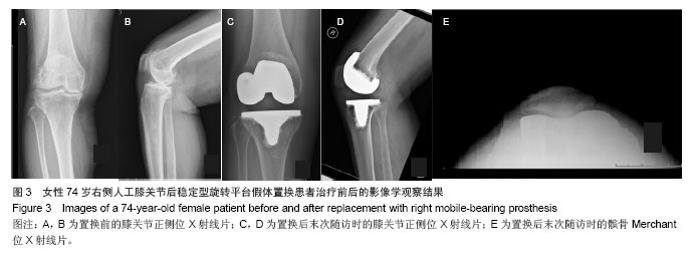
2.4 X射线评估结果 Merchant位X射线测得患者髌股关节对合角和髌骨倾斜角分别为(5.48±2.25)°,(11.23±3.22)°。 2.5 典型病例 74岁女性右膝骨关节炎患者,2007年1月予行右侧人工膝关节后稳定型旋转平台假体置换治疗,2014年1月末次随访,膝关节各项评分及关节活动度和伸屈效果满意,未出现假体松动、髌骨弹响等不良情况。X射线图像见图3。 2.6 不良事件 1例骨关节炎患者于住院间出现早期关节内感染,予以打开关节腔清理后治愈,未行翻修手术。2例患者出现下肢深静脉血栓,予以固定、低分子肝素应用加倍治疗(2次/d)后好转。所有患者均未出现聚乙烯垫片脱出。2例患者(共2膝)出现髌骨弹响。 "
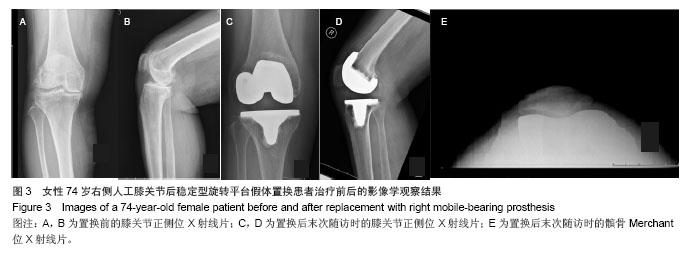
| [1]Carothers JT, Kim RH, Dennis DA, et al. Mobile-bearing total knee arthroplasty: a meta-analysis. J Arthroplasty. 2011;(4): 537-542.
[2]James C, Kevin T. Comparisons between mobile-bearing and fixed-bearing total knee replacement. Curr Orthop Prac.2009; 20(1):35-39.
[3]Sehat K, Devane P, Horne G. Fixed-bearing or mobile-bearing total knee arthroplasty? A review of the recent literature.Curr Opin Orthop. 2007;18:66-70.
[4]Skwara A, Tibesku CO, Ostermeier S, et al. Differences in patellofemoral contact stresses between mobile-bearing and fFixed-bearing total knee arthroplasties: a dynamic in vitro measurement. Arch Orthop Trauma Surg. 2009;129(7): 901-907.
[5]Callaghan JJ, Insall JN, Greenwald AS, et al. Mobile-bearing knee replacement: concepts and results. Instr Course Lect. 2001;50:431-449.
[6]O'Connor JJ, Goodfellow JW. Theory and practice of meniscal kneereplacement: designing against wear. Proc Inst Mech Eng H. 1996;210(3): 217-222.
[7]Woolson ST, Epstein NJ, Huddleston JI. Long-term comparison of mobile-bearing vs fixed-bearing total knee arthroplasty. J Arthroplasty. 2011;26(8):1219-1223.
[8]Raviraj A, Prabhu A, Pai S, et al. Fixed vs. Mobile-bearing total knee arthroplasty: does it make a difference?-a prospective randomized study. J Arthroplasty. 2010;25(5): 835.
[9]Oh KJ, Pandher DS, Lee SH, et al. Meta-analysis comparing outcomes of Fixed-bearing and Mobile-bearing prostheses in total knee arthro-plasty. J Arthroplasty. 2009;24(6):873-884.
[10]张博,潘江,林源,等. 国人膝关节参数对假体设计的意义[J].中国组织工程研究与临床康复, 2010,14(48):8941-8944.
[11]Feller JA, Bartlett RJ, Lang DM. Patellar resurfacing versus retention in total knee arthroplasty. J Bone Joint Surg Br. 1996; 78(2):226-228.
[12]Price AJ, Rees JL, Beard D, et al. A mobile-bearing total knee prosthesis compared with a fixed-bearing prosthesis. A multicentre single-blind randomised controlled trial.J Bone Joint Surg Br. 2003;85(1):62-67.
[13]Geiger F, Mau H, Krüger M, et al. Comparison of a new mobile-bearing total knee prosthesis with a fixed-bearing prosthesis: a matched pair analysis. Arch Orthop Trauma Surg. 2008;128(3):285-291.
[14]Harrington MA, Hopkinson WJ, Hsu P, et al. Fixed- vs mobile-bearing total knee arthroplasty: does it make a difference?--a prospective randomized study. J Arthroplasty. 2009;24(6 Suppl):24-27.
[15]Ball ST, Sanchez HB,Mahoney OM, et al. Fixed Versus Rotating Platform Total Knee Arthroplasty: A Prospective, Randomized,Single-Blind Study. J Arthroplasty. 2011;26(4): 531-536.
[16]Lizaur-Utrilla A, Sanz-Reig J, Trigueros-Rentero MA.Greater satisfaction in older patients with a mobile-bearing compared with fixed-bearing total knee arthroplasty. J Arthroplasty.2012; 27(2):207-212.
[17]Smith H, Jan M, Mahomed NN, et al. Meta-analysis and systematic review of clinical outcomes comparing mobile bearing and fixed bearing total knee arthroplasty.J Arthroplasty. 2011;26(8):1205-1213.
[18]Rahman WA, Garbuz DS, Masri BA. Randomized Controlled Trial of Radiographic and Patient-Assessed Outcomes Following Fixed Versus Rotating Platform Total Knee Arthroplasty. J Arthroplasty. 2010;25(8):1201-1208.
[19]Kim YH, Kim DY, Kim JS. Simultaneous mobile- and fixed-bearing total knee replacements in the same patients: a prospective comparison of mid-term outcomes using a similar design of prosthesis. J Bone Joint Surg[Br]. 2007;89-B:904.
[20]Aggarwal AK, Agrawal A. Mobile vs fixed-bearing total knee arthroplasty performed by a single surgeon: a 4- to 6.5-year randomized, prospective, controlled, double-blinded study.J Arthroplasty. 2013;28(10):1712-1716.
[21]Lädermann A, Lübbeke A, Stern R, et al. Fixed-bearing versus mobile-bearing total knee arthroplasty: a prospective randomised, clinical and radiological study with mid-term results at 7 years. Knee. 2008;15(3):206-210.
[22]Laskin RS. Lateral release rates after total knee arthroplasty. Clin Orthop Relat Res. 2001;(392):88-93.
[23]Berger RA, Rubash HE, Seel MJ, et al. Determining the rotational alignment of the femoral component in total knee arthroplasty using the epicondylar axis. Clin Orthop Relat Res. 1993;(286):40-47.
[24]陶坤,蔡明,张立国,等.旋转平台全膝关节置换术中胫骨假体的旋转安放及相关研究[J].中国骨与关节外科,2009 ,2(4) :264-268.
[25]Rees JL, Beard DJ, Price AJ, et al. Real in vivo kinematic differences between mobile-bearing and fixed-bearing total kneearthroplasties. Clin Orthop Relat Res. 2005;(432): 204-209.
[26]Callaghan JJ, Squire MW, Goetz DD, et al. Cemented rotating-platform total knee replacement. A nine to twelve-year follow-up study. J Bone Joint Surg Am. 2000; 82(5):705-711.
[27]Sawaguchi N, Majima T, Ishigaki T, et al. Mobile-bearing total knee arthroplasty improves patellar tracking and patellofemoral contact stress: in vivo measurements in the same patients.J Arthroplasty. 2010;25(6):920-925.
[28]Ranawat ASRR, Loreti I. Patellofemoral tracking in posterior stabilized mobile bearing total arthroplasty. East Orthop Assoc Poster. 2004.
[29]Bert JM. Dislocation/subluxation of meniscal bearing elements after New Jersey low-contact stresstotal knee arthroplasty.Clin Orthop Relat Res. 1990;(254):211-215.
[30]Kim YH, Kook HK, Kim JS. Comparison of Fixed-Bearing and Mobile-Bearing Total Knee Arthroplasties. Clin Orthop Relat Res. 2001;392:101-115.
[31]Thompson NW, Wilson DS, Cran GW, et al. Dislocation of the rotating platform after low contact stress total knee arthroplasty. Clin Orthop Relat Res. 2004;(425):207-211.
[32]Hasegawa M, Sudo A, Fukuda A, et al. Dislocation of posterior-stabilized mobile-bearing knee prosthesis. Acase report. Knee. 2006;13(6):478-482.
[33]Agarwala SR, Mohrir GS, Patel AG. Patellar clunk syndrome in a current high flexion total knee design.J Arthroplasty. 2013; 28(10):1846-1850.
[34]Fukunaga K, Kobayashi A, Minoda Y, et al. The incidence of the patellar clunk syndrome in a recently designed Mobile-bearing posteriorly stabilised total knee replacement. J Bone Joint Surg Br. 2009;91:463.
[35]Frye BM, Floyd MW, Pham DC, et al. Effect of femoral component design on patellofemoral crepitance and patella clunksyndrome after posterior-stabilized total knee arthroplasty. J Arthroplasty. 2012;27(6):1166-1170.
[36]王晓峰,陈百成,师晨霞,等.固定平台型和移动平台型假体全膝关节置换术后临床效果的分析比较[J]. 中国矫形外科杂志,2007, 15(18):1367-1370.
[37]Gioe TJ, Glynn J, Sembrano J, et al. Mobile and fixed-bearing (all-polyethylene tibial component) total knee arthroplasty designs. A prospective randomized trial. J Bone Joint Surg Am. 2009;91:2104-2112.
[38]Lu YC, Huang CH, Chang TK, et al. Wear-pattern analysis in retrieved tibial inserts of mobile-bearing and fixed-bearing total knee prostheses.J Bone Joint Surg [Br]. 2010; 92-B: 500-507.
[39]Engh GA, Zimmerman RL, Parks NL, et al. Analysis of wear in retrieved mobile and fixed bearing knee inserts. J Arthroplasty. 2009;24(6 Suppl):28-32.
[40]Atwood SA, Currier JH, Mayor MB, et al. Clinical wear measurement on low contact stress rotating platform knee bearings.J Arthroplasty. 2008;23(3):431-440. |
| [1] | Peng Zhihao, Feng Zongquan, Zou Yonggen, Niu Guoqing, Wu Feng. Relationship of lower limb force line and the progression of lateral compartment arthritis after unicompartmental knee arthroplasty with mobile bearing [J]. Chinese Journal of Tissue Engineering Research, 2021, 25(9): 1368-1374. |
| [2] | Huang Dengcheng, Wang Zhike, Cao Xuewei. Comparison of the short-term efficacy of extracorporeal shock wave therapy for middle-aged and elderly knee osteoarthritis: a meta-analysis [J]. Chinese Journal of Tissue Engineering Research, 2021, 25(9): 1471-1476. |
| [3] | Liu Xiangxiang, Huang Yunmei, Chen Wenlie, Lin Ruhui, Lu Xiaodong, Li Zuanfang, Xu Yaye, Huang Meiya, Li Xihai. Ultrastructural changes of the white zone cells of the meniscus in a rat model of early osteoarthritis [J]. Chinese Journal of Tissue Engineering Research, 2021, 25(8): 1237-1242. |
| [4] | Liu Xin, Yan Feihua, Hong Kunhao. Delaying cartilage degeneration by regulating the expression of aquaporins in rats with knee osteoarthritis [J]. Chinese Journal of Tissue Engineering Research, 2021, 25(5): 668-673. |
| [5] | Ma Zetao, Zeng Hui, Wang Deli, Weng Jian, Feng Song. MicroRNA-138-5p regulates chondrocyte proliferation and autophagy [J]. Chinese Journal of Tissue Engineering Research, 2021, 25(5): 674-678. |
| [6] | Cao Xuhan, Bai Zixing, Sun Chengyi, Yang Yanjun, Sun Weidong. Mechanism of “Ruxiang-Moyao” herbal pair in the treatment of knee osteoarthritis based on network pharmacology [J]. Chinese Journal of Tissue Engineering Research, 2021, 25(5): 746-753. |
| [7] | Li Yonghua, Feng Qiang, Tan Renting, Huang Shifu, Qiu Jinlong, Yin Heng. Molecular mechanism of Eucommia ulmoides active ingredients treating synovitis of knee osteoarthritis: an analysis based on network pharmacology [J]. Chinese Journal of Tissue Engineering Research, 2021, 25(5): 765-771. |
| [8] | Song Shan, Hu Fangyuan, Qiao Jun, Wang Jia, Zhang Shengxiao, Li Xiaofeng. An insight into biomarkers of osteoarthritis synovium based on bioinformatics [J]. Chinese Journal of Tissue Engineering Research, 2021, 25(5): 785-790. |
| [9] | Deng Zhenhan, Huang Yong, Xiao Lulu, Chen Yulin, Zhu Weimin, Lu Wei, Wang Daping. Role and application of bone morphogenetic proteins in articular cartilage regeneration [J]. Chinese Journal of Tissue Engineering Research, 2021, 25(5): 798-806. |
| [10] | Zheng Li, Li Dadi, Hu Weifan, Tang Jinlong, Zhao Fengchao. Risk assessment of contralateral knee arthroplasty after unilateral total knee arthroplasty [J]. Chinese Journal of Tissue Engineering Research, 2021, 25(3): 374-379. |
| [11] | Lü Jiaxing, Bai Leipeng, Yang Zhaoxin, Miao Yuesong, Jin Yu, Li Zhehong, Sun Guangpu, Xu Ying, Zhang Qingzhu. Evaluation of internal fixation with proximal femoral nail antirotation in elderly knee osteoarthritis patients with femoral intertrochanteric fractures [J]. Chinese Journal of Tissue Engineering Research, 2021, 25(3): 391-396. |
| [12] | Liu Jianyou, Jia Zhongwei, Niu Jiawei, Cao Xinjie, Zhang Dong, Wei Jie. A new method for measuring the anteversion angle of the femoral neck by constructing the three-dimensional digital model of the femur [J]. Chinese Journal of Tissue Engineering Research, 2021, 25(24): 3779-3783. |
| [13] | Luo Anyu, Liu Hanlin, Xie Xiaofei, Huang Chen. Effect of antioxidant mixture on structural degeneration of an osteoarthritis rat model [J]. Chinese Journal of Tissue Engineering Research, 2021, 25(23): 3625-3629. |
| [14] | Gao Kun, Chen Dayu, Zhang Yong, Liu Weidong, Sun Shufen, Lai Wenqiang, Ma Dujun, Wu Yihong, Lin Zhanpeng, Jiang Yinglu, Yu Weiji. Achyranthes bidentata alcohol extract inhibits extracellular matrix degradation of the cartilage by regulating synovial fibroblast exosomes [J]. Chinese Journal of Tissue Engineering Research, 2021, 25(23): 3636-3640. |
| [15] | Liu Jinfu, Zeng Ping, Nong Jiao, Fan Siqi, Feng Chengqin, Huang Jiaxing. Integrative analysis of biomarkers and therapeutic targets in synovium of patients with osteoarthritis by multiple microarrays [J]. Chinese Journal of Tissue Engineering Research, 2021, 25(23): 3690-3696. |
| Viewed | ||||||
|
Full text |
|
|||||
|
Abstract |
|
|||||
